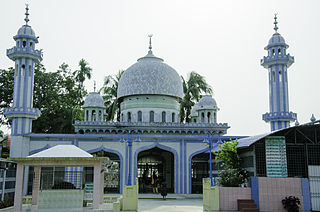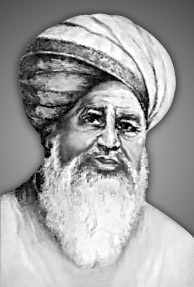
Dhaka Division is an administrative division within Bangladesh. Dhaka serves as the capital city of the Dhaka Division, the Dhaka District and Bangladesh. The division remains a population magnet, covers an area of 20,508.8 km2 with a population in excess of 44 million, It is the most populous country second level division of the world, growing at 1.94% rate since prior count, compared with national average of 1.22%. However, national figures may include data skewing expatriation of male labor force as gender ratio is skewed towards females.

Manikganj is a district in central Bangladesh and part of the Dhaka Division. Established in 1845, it was originally a subdivision of Faridpur District. In 1956, it was included in Dhaka District for administrative purposes. In 1984, Manikganj was declared a full district.

Faridpur District is a district in south-central Bangladesh. It is a part of the Dhaka Division. It is bounded by the Padma River to the northeast. The district was named for its headquarters Faridpur town, which itself was named for Farīd-ud-Dīn Masʿūd, a 13th-century Sufi saint. A separate district was created by severing Dhaka district in 1786 and was called Dacca Jelalpur. A municipality was established in 1869. Historically, the town was known as Fatehabad. It was also called Haveli Mahal Fatehabad.

Madaripur is a district in central Bangladesh and a part of the Dhaka Division.

Shariatpur is a district in the Dhaka Division of central Bangladesh.

Dhaka (Dacca) is one of the oldest inhabited mega cities of the World. The history of Dhaka begins with the existence of urbanised settlements in the area that is now Dhaka dating from the 7th century CE. The city area was ruled by the Hindu Gauda Kingdom, Buddhist and Shaivite Pala Empire before passing to the control of the Hindu Sena dynasty in the 10th century CE. After the Sena dynasty, the city was ruled by the Hindu Deva Dynasty. Dhaka was successively ruled by the Turkic and Afghan governors descending from the Delhi Sultanate, followed by the Bengal Sultanate, before the arrival of the Mughals in 1608. The city became proto-industrialised and declared capital of the Mughal Bengal and commercial (financial) capital of the Mughal India. The Dhaka natural riverine port has a recorded existence since the 16th century CE. Dhaka's strategic riverine location in Bengal made it a hub for Eurasian traders, including Armenians, the Portuguese, French, Dutch and British. The bustling old city was known as the Venice of the East. After Mughals, British ruled the region for 200 years until the independence of India in 1947. After the independence of Bangladesh in 1971, Dhaka became the capital of the new state.

Haji Shariatullah was a prominent religious leader and Islamic scholar from Bengal in the eastern subcontinent, who is best known as the founder of the Faraizi movement. In 1884, the Shariatpur District was formed and named after him.
The Pagal Panthis were a socio-religious order that emerged in the late 18th-century in the Mymensingh region of Bengal. Adherents of a syncretic mixture of Hinduism, Sufism and Animism, the order sought to uphold religious principles and the rights of landless peasants in Bengal; under the leadership of Tipu Shah, the movement soon evolved into a popular, armed struggle against the British East India Company and the zamindar (landlord) system. It was crushed with the help of the army in 1833. It was a semi religious sect having influence in the northern districts of Bengal. Pagal panthi movement was of Hodi, Garo and Hajong tribes. It was led by Hodi leader Janku Pathar and Debraj Pathar.

Sikhism in Bangladesh has an extensive heritage and history, although Sikhs had always been a minority community in Bengal. Their founder, Guru Nanak visited a number of places in Bengal in the early sixteenth century where he introduced Sikhism to locals and founded numerous establishments. In its early history, the Sikh gurus despatched their followers to propagate Sikh teachings in Bengal and issued hukamnamas to that region. Guru Tegh Bahadur lived in Bengal for two years, and his successor Guru Gobind Singh also visited the region. Sikhism in Bengal continued to exist during the colonial period as Sikhs found employment in the region, but it declined after the partition in 1947. Among the eighteen historical gurdwaras in Bangladesh, only five are extant. The Gurdwara Nanak Shahi of Dhaka is the principal and largest gurdwara in the country. The Sikh population in the country almost entirely consists of businessmen and government officials from the neighbouring Republic of India.
Muḥsin ad-Dīn Aḥmad (1819–1862), better known by his nickname Dudu Miyān, was a leader of the Faraizi Movement in Bengal. He played an active role in the Indian Rebellion of 1857.
Mohammad Rowshan Ali Chowdhury was a Bengali journalist, writer, poet and politician.
Taluqdar is a historic occupational title in South Asia which is now used as a surname. Notable people with the surname include:

Tanda, also known as Tandah and Khwaspur Tandah, was a historic 16th-century city of Bengal in the eastern part of South Asia, and one of the most prominent medieval capitals; serving the Karrani Sultans of Bengal and the early Mughal governors of Bengal.

The Greater Jessore region predominantly includes the districts of Jessore, Jhenaidah, Narail and Magura in Bangladesh, as well as the Bangaon subdivision of India. Nestled close to the Sundarbans, the region experienced human settlement early on. It served as the capital city of the Samatata realm and passed through several Buddhist and Hindu kingdoms such as the Palas and Senas. Jessore was ruled by Khan Jahan Ali of Khalifatabad, under the Muslim Sultanate of Bengal, who is credited with establishing the Qasbah of Murali and urbanising the region through advancements in transportation and civilization. Jessore later came to be ruled by various chieftains such as Pratapaditya and became familiar to contemporary European travellers as Chandecan before being annexed to the Mughal Empire in the seventeenth century. By 1757, the British East India Company had dominated and started to establish themselves in the region. British rule lasted up until 1947, with Jessore coming under the Provisional Government of Bangladesh from 1971 onwards.
Karāmat ʿAlī Jaunpūrī, born as Muḥammad ʿAlī Jaunpūrī, was a nineteenth-century Indian Muslim social reformer and founder of the Taiyuni movement. He played a major role in propagating to the masses of Bengal and Assam via public sermons, and has written over forty books. Syed Ameer Ali is among one of his notable students.

Ḥāfiẓ Aḥmad Jaunpūrī was an Indian Muslim scholar, religious preacher and social worker. As the son and successor of Karamat Ali Jaunpuri, he led the Taiyuni reformist movement in Bengal.

ʿAbd al-Awwal Jaunpūrī was an Indian Muslim scholar, religious preacher, educationist, poet and author. Described by Muhammad Mojlum Khan as one of the "most gifted and outstanding" of Karamat Ali Jaunpuri's many children, he displayed an important role leading his father's founded Taiyuni reformist movement in Bengal.

Nesaruddin Ahmad was a Bengali Islamic scholar, spiritual reformer, educationist and writer. He was the main disciple of Furfura Sharif's Mohammad Abu Bakr Siddique in eastern Bengal. Ahmad was the inaugural Pir of Sarsina, having founded the Sarsina Darbar Sharif and Darussunnat Kamil Madrasa in 1915, one of the largest Islamic institutions in South Bengal and the first major alia madrasah after Calcutta. Ahmad was among the leading Islamic leaders in colonial Barisal, and his influence extended across Bengal. The Nesarabad Upazila of Bangladesh has been named after him.
Munshi Azimuddin Hanafi (1838–1922) was a Bengali Islamic scholar, social reformer, orator, poet and author.













